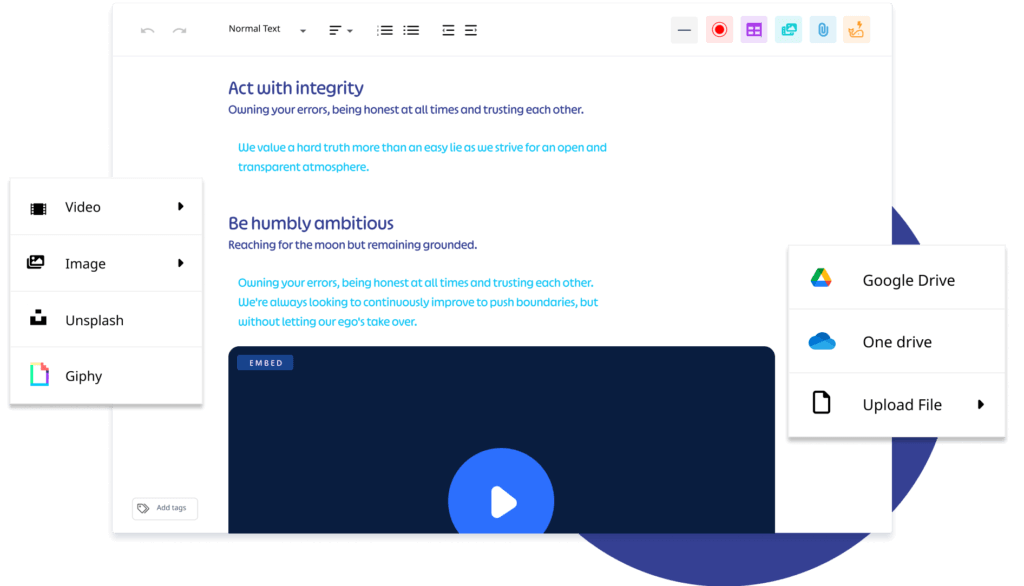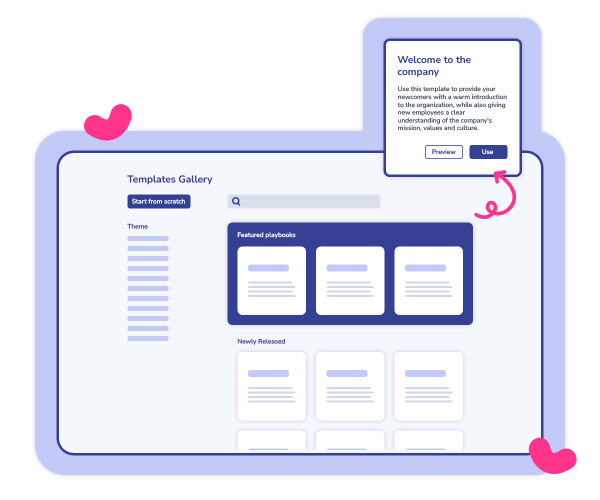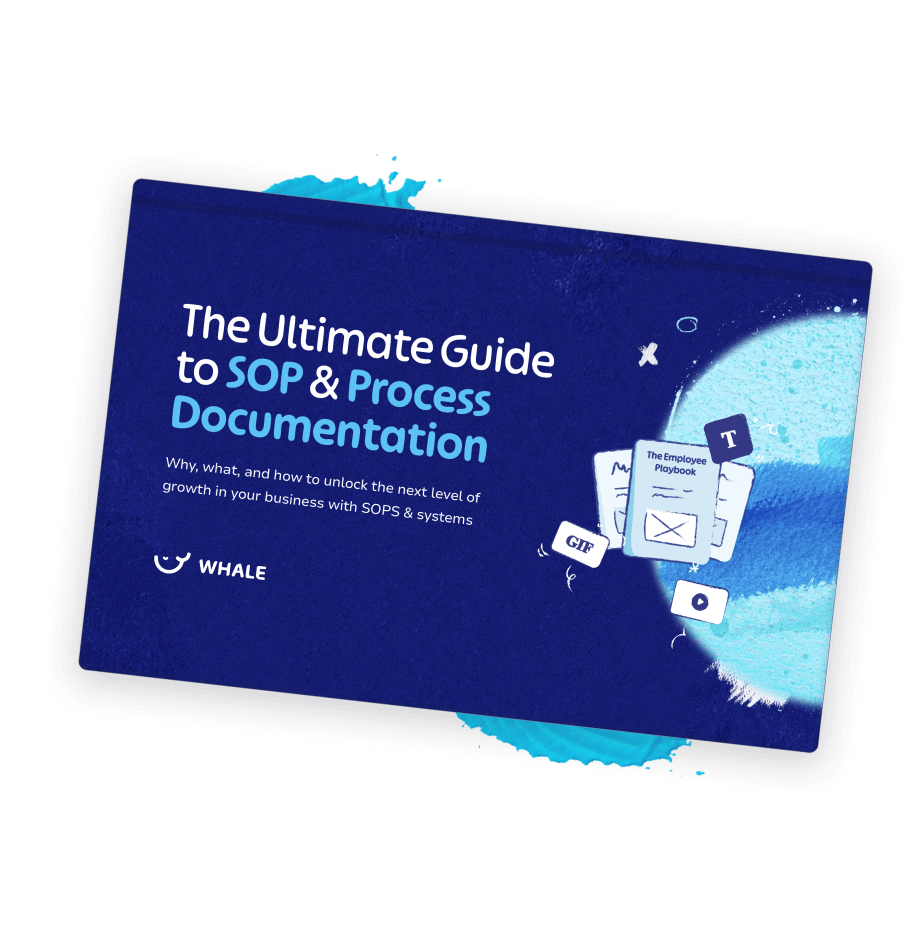Writing SOPs takes a ton of time, right?
Wrong. You can get your SOPs done in no time! And without mistakes!
Today, we’re exploring how to write effective SOPs and the easy guidelines you need to get them done. Fast.
But first, what exactly are SOPs? And how can you write the best SOPs?
What are SOPs?
Standard Operating Procedures, or SOPs, are easy-to-understand documents that create process workflows for performing defined tasks.
This could refer to various procedures within a business, such as onboarding new employees or clients. They can also include managing worklists and tasks, or tracking project deliverables.
Having effectively developed SOPs in your business creates increased efficiency and, therefore, profitability.
Documentation also reduces the risk of errors in your procedures and a standardized consistency in your clients’ products and services.
As long as your team reads them☝️. Let’s explore some SOP writing guidelines so your team not only reads them but uses them too!
4 Ways to write SOPs
Whilst many businesses understand the need for Standard Operating Procedures (SOPs), they often struggle with the best ways to approach them. At Whale, we specialize in helping businesses simplify and modernize their training approach and materials.
Here are 4 ways to write SOPs and process documentation;
- Use Whale’s AI assist to create a SOP from scratch in seconds
- Use a template to get you started
- Hire a Whale-certified partner to help you create the best documentation
- DIY, and yes, it can be easy to create the best documentation in-house.
Standard operating procedure (SOP) writing guidelines
This does NOT have to be difficult. Forget the idea that this is going to be time consuming or that it’s something insurmountable.
☝️ The first and most important point to keep in mind is that writing SOP and process documentation can be easy!
Here are a few additional considerations;
Think about the why
Ice Baby said it best when he said "Stop, Collaborate and Listen!".
Before you start writing, know what you want to achieve (the purpose of the SOP). Also, think about the current process (if there is one) and if it can at all be improved.

Consider the audience
Will the procedures be utilized by a broader team to ensure consistent performance? If so, develop a detailed, step-by-step process that aligns with their skill level and familiarity with the tools and technologies employed.
Are you an owner striving to establish a business that can operate efficiently without your constant presence? In that case, documenting the processes you’ve devised for future successors will prove beneficial.
Involve subject matter experts
You can continuously improve your SOPs and process documentation by assigning subject matter experts and team members who are in touch with the process and can ensure documentation and processes are reviewed and updated.
Start writing your SOPs in no time
Now that you understand what you need to write and who will be using it, create a document that outlines each step and assigns ownership for each task. Utilize the provided SOP format below or simply use one of the Whale templates.
Additional tips for writing SOPs
When writing SOPs for your business, it’s essential always to remember who they’re being written for – the end-user.
Ensuring they are easy to understand and make sense to the person reading them is crucial to ensuring they are fit for purpose.
Here are a few things to bear in mind when writing your procedures:
- Use clear and simple language:
Your SOPs need to be written in a way that takes the reader on a straightforward, step-by-step process from start to finish. Use simple language without any ambiguous terminology. - Break your document up into logical steps
Breaking your document up under logical headers and sections will help the reader follow it and retain the knowledge you’re providing. - Make the crucial points evident to the reader
If there are any critical pieces of information that the reader must know, make sure these aren’t hidden within the text, and there is no confusion over their purpose. - Keep your SOPs updated
SOPs should be live documents that are reviewed and updated as your internal processes and procedures are developed. Make sure you schedule regular reviews to ensure they remain fit for purpose.
And the most important thing? Make it enjoyable to read! There’s a reason watch Netflix and there should be a reason that people want to read your company documentation.
DO…
- ✅ Make it easy to understand
- ✅ Make it visually appealing
- ✅ Answer the question who does what and how?
DON’T…
- ❌ Use jargon and difficult terminology
- ❌ Make it difficult to understand
How to format your SOPs?
At the end of the day it’s really important that the formatting of your SOPs and company documentation is designed for ease of use.
❌ No one wants to read a boring 6-page typed document when trying to find information. Create an engaging experience by using rich media and yes, even emojis 😀.

- Header
A brief but clear title identifying your activity and any relevant keywords, plus your version number. - Purpose
Use this section to define the intent of your document clearly and concisely. - Scope
This section will outline what is in scope for the document and what is not in scope. Ensure that nothing is left up to interpretation and that the reader has no doubt what the document will provide them with. - Definitions
Make sure that any terms which may not be familiar to the reader are defined – this includes abbreviations or industry terms. - Roles & Responsibilities
Clearly outline the roles responsible for carrying out the procedure outlined in the document.
Procedure
Make sure you only include steps required for the procedure to be appropriately maintained. It may help break it down into easy-to-follow sections that can be quickly followed and checked off as the reader goes through the document. - Appendices
Use this section to assist your reader in understanding the process, potentially with visual aids such as diagrams and process flows. - Version control
Keep a record of any changes made to the document over time, including why you made the changes. Luckily at Whale, this is an in-built feature.
Different examples and types of SOPs
The way write your SOPs will also depend on the area of the business you’re creating documentation for. In addition, the types of SOPs you’ll create for your business will vary depending on your industry. However, some of the most common areas to implement include:
Marketing SOPs
This will usually cover guidance on how the business presents itself in external communications, such as social media, press releases, or advertising campaigns. It can also extend to preparing sales quotes, service delivery processes, response times, and resolution of refunds/exchanges and complaints.
👉 Get your Marketing template here.
Finance SOPs
Finance SOPs can define processes within billing and collecting and accounts payable. This can help provide clear instruction to clients and increase cashflow within the business.
👉 Get your Finance template here.
Employee Onboarding SOPs
Bringing in new staff members can be a time-consuming procedure. However, having clear SOPs in place will ensure a straightforward and pain-free process for both you and your new employee. These can be put in place for building job descriptions, inductions and training, performance reviews, and corrective action.
👉 Get your Employee template here.
HR SOPs
Bringing in new staff members can be a time-consuming procedure. However, having clear SOPs in place will ensure a straightforward and pain-free process for both you and your new employee. These can be put in place for building job descriptions, inductions and training, performance reviews, and corrective action.
👉 Get your HR templates here.
FAQs
How do you create a good standard operating procedure?
Use this checklist to make sure your SOP delivers maximum ROI and benefit to all involved:
- Identify documentation needs: List business processes that require documentation, prioritizing with input from employees and managers.
- Understand the SOP purpose: Determine whether the SOP is for documenting a new process or updating an existing one, and what you want to achieve.
- Define your audience: Tailor the SOP to the user’s background and language abilities, incorporating visuals if necessary to aid understanding.
- Assemble a documentation team: Include subject matter experts (SMEs) and frontline employees who are familiar with the processes to gather accurate and practical content.
- Select an SOP format: Choose a format that suits organizational needs, ranging from formal documents with metadata to simple checklists or workflow diagrams.
- Determine distribution method: Decide how the SOPs will be published and shared for easy accessibility, considering both digital and physical storage options.
- Define documentation scope: Define the scope of your documentation by specifying tasks, departments, teams, or roles and setting process limits.
- Use Templates or AI to begin: Start with a chosen template as an outline and flesh out details as you research and document procedures.
- Define success metrics: Establish measurable metrics within the SOP to assess its effectiveness and ensure procedures are clear and actionable.
- Plan for regular updates: Schedule annual reviews and updates of the SOP to comply with internal practices and regulatory standards.
What are the 5 parts of a SOP?
Here are the five key parts typically included in an SOP:
Title Page: This page includes the title of the SOP, the department or team it applies to, the SOP number, and the date it was issued or last revised. This section often also includes the signatures or approval of the managers or other authorities overseeing the procedures.
Purpose and Scope: This section describes the objective of the SOP and outlines the context in which the SOP should be used. It defines the limits of the procedure and clarifies what it aims to accomplish, helping users understand the intended outcome and applicational boundaries.
Responsibilities and Roles: Here, the SOP identifies who is responsible for executing each part of the procedure. It defines roles and responsibilities clearly to ensure there is no confusion about who needs to do what. This part often includes information on training or qualifications required to perform the tasks outlined.
Procedure: This is the main body of the SOP and includes the detailed step-by-step instructions on how to perform the tasks. It is usually structured in a sequential format and may include diagrams, flowcharts, or other visual aids to assist in understanding the processes. Clear and concise language is used to ensure the steps are easily understood and executed.
Version control: This shows when the SOP was updated and by whom so everyone knows how up to date the document is.
Other sections can also be included, such as definitions, required materials and equipment, and references, depending on the complexity and needs of the procedure.
How do you write a SOP example
You typically don’t have to do too much writing for your SOPs these days. With the help of a template of AI, you can get started in seconds.
If you do use a template or AI, remember to customize it according to;
- Your brand tone of voice
- Your specific objectives
Also remember to use rich media, video and infographics to make it engaging.
Bottom line?
We hope these SOP writing guidelines have been helpful to get you on the right path to writing effective SOPs for your business. At Whale, we do however understand that the process can be time-consuming.
We’ve built our technology to assist businesses in simplifying their documentation process, deliver information to staff in bite-sized chunks when they need it and understand it best.
If you enjoyed this blog, you may also enjoy these resources;
- How to Ace Your Business Process Documentation in 4 Simple Steps.
- SOP Creation: Getting Started with Your Documentation Journey
Ultimate Guide to SOP & Process Documentation
The why, what, and how to unlock the next level of growth in your business with SOPS & systems









